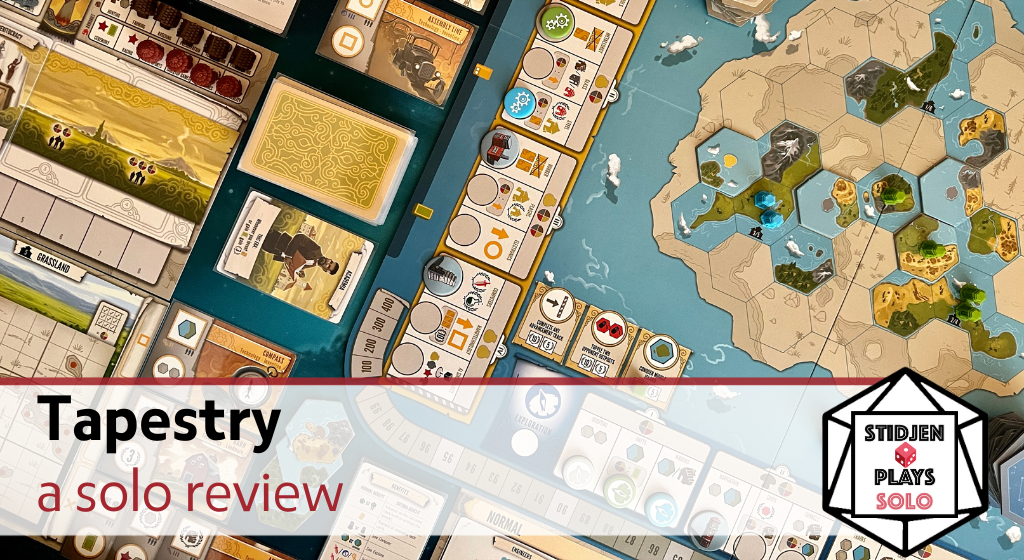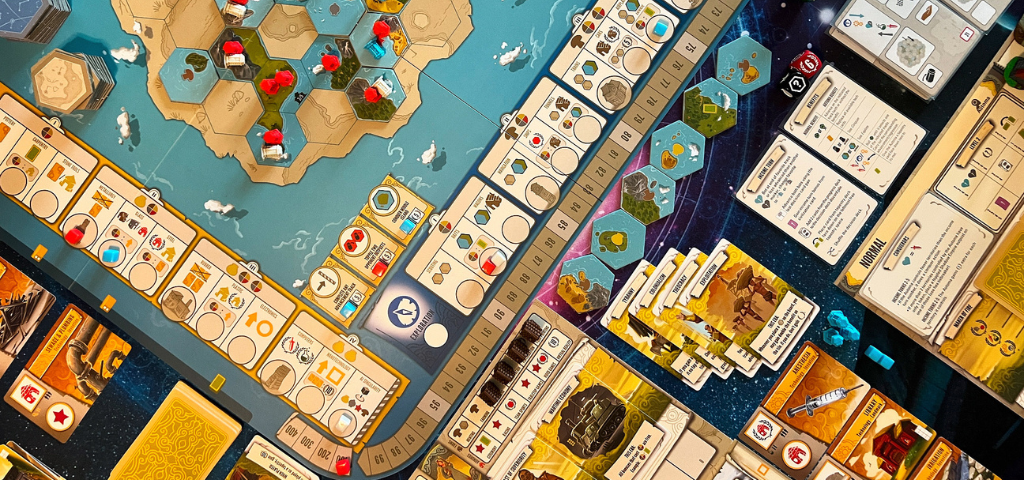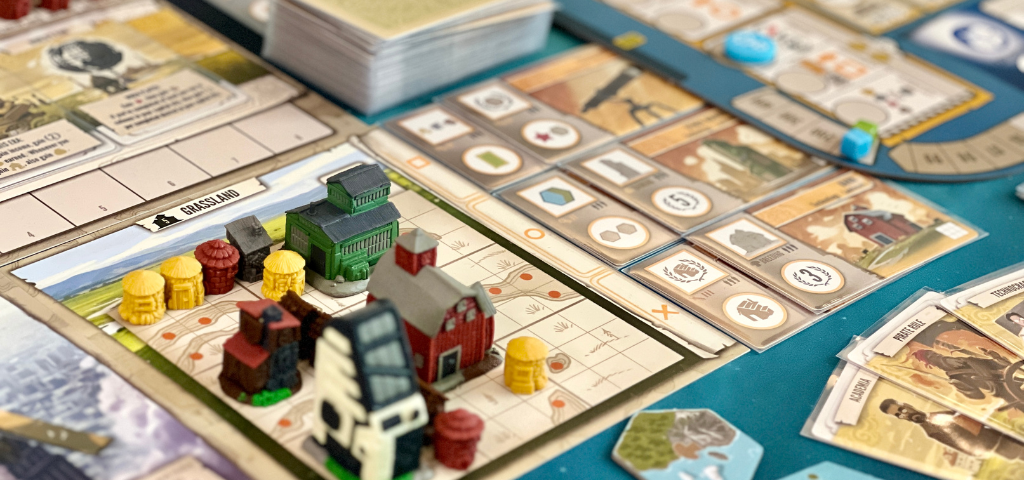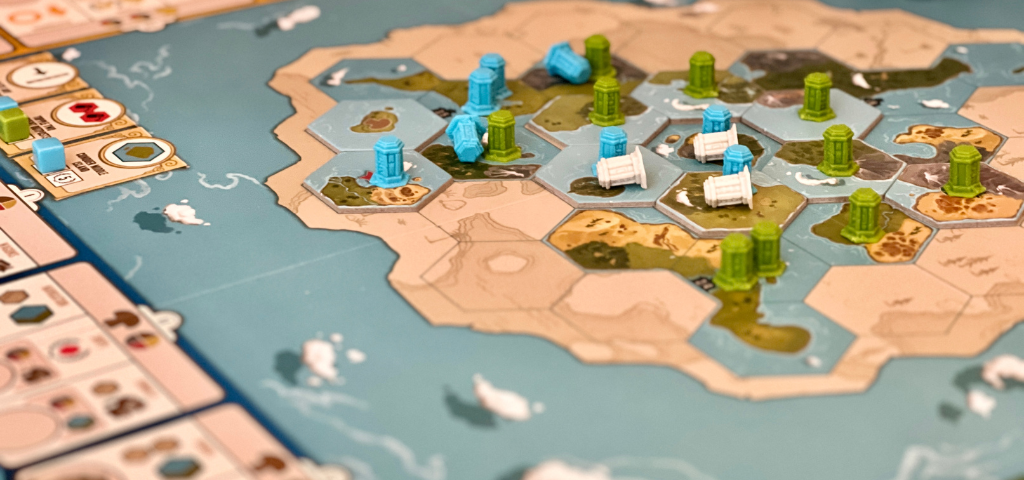
Are not all our actions but memories as soon as we have acted them? Are they not carbon copies that get worn with age – more open to interpretation with every iteration? Even as we channel our recollection into words on the page, we lose something. The same holds true for tapestries detailing a civilization’s glorious past, but what they exactly represent is in the eye of the beholder.
Name: Tapestry (2019)
Designer: Jamey Stegmaier
Publisher: Stonemaier Games
Play type: variable player powers, income, tech trees, map addition

What the game is about
Can you lead your civilization through greatness across five eras? In Tapestry, you will control a unique civilization as it advances through science, exploration, technology, and militarism while trying to outpace, outsmart, or outfight opposing forces. Will you emerge victorious from this multi-faceted arms race?
How the game works
Tapestry is a game in which you advance on four different tracks to advance your unique civilization. You do this for four eras until your resources run out. You get a unique civilization (draw two, pick one), a unique capital city mat (where you will be keeping track of your income and where you will be building an abstracted spatial version of your capital), a special Tapestry card with a one-time or ongoing bonus, and the first round of income.
During your turn, you will do one of two things: either you pay the resources to advance on one of the four tracks (Technology, Exploration, Science, and Military), or you take an income turn. When you take an income turn, you gain the resources shown on the tracks on your capital mat. This is where you track your income and an abstract spatial representation of how your civilization is expanding. Every time you gain an income building, you take it from its track and put it anywhere in your capital city. Completing a 3*3 sector gains you one bonus resource while completing rows and/or columns can give you end-game scoring.
When you advance on a track, you take the respective action. Sometimes, you can pay extra resources to take a bonus action. Each track is divided into four regions, everyone a bit more expensive than the last. The game uses four resources you can pay with – food, coin, worker, and culture. The first player to cross into a new advancement track tier gains the special landmark connected to that space. These unique buildings of varying shapes and sizes can take up large plots in your capital.
When playing solo, you are basically playing against 1.5 opponents. The Automa is the one you’re trying to beat, while the Shadow Empire is advancing on the tracks too, gaining landmarks for the Automa. For the Automa, you choose or randomly decide their ‘fraction’, which gives it their favoured track (the Shadow Empire uses another) and perhaps an additional ability. The Automa and Shadow Empire use two cards at a time to determine their actions and tiebreakers. The Automa ‘cheats’ in certain actions and how they score points. You can adjust their difficulty in four different tiers.
The game ends after the fifth era is complete for all players, the Automa, and the Shadow Empire. You score points for certain track advancements, income mat upgrades, tech cards, Tapestry cards, and other bonuses.

Theme, setting & narrative
Let’s get the elephant out of the room: is Tapestry a civilization game? It flauntingly calls itself that on the box cover, but it has been up for fiery debate since the game was announced well before its release. ‘Is game X a Y-game?’ is a question that gets asked for many games, especially as they exist on the more abstract side of the spectrum. And most of the time, it is a matter of taste. So why should Tapestry get a different treatment? Because it claims on the box that it is a civilization game.
Is A Feast for Odin thematic? It kind of is if you allow it to. I think the same holds true for Tapestry, but the mere existence of the c-word on the front of the box is grounds for division among players. What you are doing here is basically just pushing cubes up on various tracks. I think the game calling itself a civ game is a bold move, and I don’t think it warrants the subtitle. It creates an unnecessary semantic discussion that detracts from the experience. Rather paradoxically, I think the game would’ve felt more like a civ game had they not put it on the front of the box.
In the end, all that matters is whether or not you feel like you are playing a civ game, and I say that to me, it does. There are enough elements that interlock to create a cohesive thematic experience of growth and progression. Sure, the timeline can sometimes feel anachronistic in the way you discover tech or play tapestry cards, but I don’t mind; I see all of these blurbs as abstracted anyway. Either way, my civilization is progressing, and once you accept the game isn’t really a civilization game but rather the thematic abstraction of one, you’re good.

How does it play?
Being the superficial ‘ooh look, shiny!’ species that we humans are, let’s start with how the game looks and feels. Barring perhaps Chip Theory Games’ offerings, Stonemaier Games have an unblemished track record as far as game presentation is concerned – premium quality cards, thick tiles, linen-finish rulebooks, and last but not least, gorgeous and chunky pre-painted miniatures. The only negative I can think of is that the cubes you use to advance along the tracks pale compared to the rest of this box’s contents (but the BGG Store has you covered).
When you start playing Tapestry, it feels weird. What are you doing, exactly? Pushing cubes? Well, yes and no. It took me a few games to get over this aspect of the game – in fact, it took me buying the game a second time to really start to understand what was happening. Yes, you are pushing cubes on a track, but the driving force behind each move should come from a strategic plan. In my first games, I was just advancing on the tracks where I could do so, meaning I was slowly advancing everywhere. If the game was about only scoring your lowest track, then great – I would’ve knocked everyone’s socks off. But it’s not, so I got whooped because I tried to do everything and, by extension, was a master of nothing. Tapestry has some wiggle room, but it really wants you to specialize in order to maximize your actions in a grander scheme of things. Every track has a unique feel, and understanding what your civilization wants you to do is key to success.
Yes, Tapestry has resource management, but it’s not a game about wringing every single resource out of an era before you take your income turn and advance into your next era. For one, it can be advantageous to be the first to enter a new era because a) it gives you bonus resources and b) it denies the Automa points. This is where the namesake tapestry cards come in. The game is played over five eras, the middle three, which are preceded by playing such a card. These either provide a one-time or an ongoing benefit for your current era. Much planning goes into this, strengthened by some knowledge of the four research tracks, your position thereon, and other tapestry cards you might have. While your civilization provides the foundation for your game, tapestry cards can often act as the building blocks you subsequently need to build thereupon. It can occasionally be tricky to manage them, but it can be immensely satisfying to pull off a particular lucrative era. I can see a potential downside being that you can knee-cap yourself here, but I can’t say I’ve seen a death spiral in this game, i.e. cases where you make a bad decision and things only snowball negatively from there.
I just like how you constantly balance various factors, always trying to figure out the best timing for what you want to do. For example, there is a tapestry card that rewards you for every income building you place in that era. Is it worth preemptively ending your era, even when you have resources left, to enter the next one and try to score more? Or is it worth more to spend as many resources now so you get more income on subsequent turns? Tapestry is full of micro-decisions like this, never burdening you with analysis paralysis but instead tempting you with all kinds of interesting incentives.
Let’s rewind to the actual beginning of the game because this is where you lay the foundation for all the micro-decisions you’ll be making during this game. You pick one of two civilizations, get a random capital mat, and gain a tapestry card to start out with (although I suggest drawing 2 and keeping 1) on top of one of each resource. These are like different puzzle pieces that can fit together in multiple ways, and it’s up to you to make something of it.
Speaking of puzzle pieces, your capital city is a right puzzle in and of itself. It is a grid of 9 rows and 9 columns, consisting of nine 3*3 squares. Some squares already count as filled because they are impassable terrain, but still, your capital city is a blank canvas for your spatial puzzle minigame. Because whenever you complete a square, you gain one resource of your choice; meanwhile, completed rows and columns usually give you victory points. You can see the tension this creates when balancing short-term gains versus long-term payoffs. Early on, you’re just putting out single-square income buildings that you take off of your income tracks, but pretty soon, you’re in Landmark territory. These aren’t just nice and pretty, but also very valuable when filling out your capital mat. Yes, they could have been tiles, but who’s to argue their toy factor as they figure out how to place it in their city?
The solo game pits you against a full-fledged Automa as well as a Shadow Empire that acts as the Automa’s lackey in racing up tracks and gaining landmarks for the Automa to score. The Automa and Shadow Empire start out with a favourite track – the Automa’s is based on the random special civ card they have, while the Shadow Empire operates on another track determined by a die roll. This gives their actions more predicability (they often move on their most advanced track or where they’re closest to a landmark; plus, their favourite track is among the tiebreakers) and presents you with additional pieces to add to your start-of-game puzzle.
What I like most about this system is that you can manipulate the AI to forego their favourite track; if you are ahead of them when they take their income turn, they switch gears tracks. Be wary – the Automa quickly turns into a quick and ruthless track-advancing machine, but especially in the early game, it can be beneficial to stunt their growth a bit. It gives you some influence over their actions, not unlike how human opponents would act if you were to outperform them.
Both Automa and Shadow Empire use a two-card decider system to take their actions, similar to Gaia Project and not unlike Apiary – one card to determine the action, one for tiebreakers. Whenever the Automa lands on a space, they take the accompanying special action if it’s on their reference card. For example, they don’t take tech cards but refresh the market if they land on such a space; likewise, they do Conquer and Explore, albeit in a customized fashion. It’s probably a me-thing, but I just cannot grasp how this action fully works, and I have to keep looking at the various tiebreakers whenever I have to resolve them. In the early game, I’m usually okay, but especially as I’m expanding, it gets harder for me to figure out how the Automa would Conquer or Explore. I think, in general, Tapestry‘s Automa is similar to Scythe‘s, although streamlined. Still, newer Stonemaier offerings like Apiary, Expeditions and Wyrmspan (review incoming!) are a newer type of streamlined Automa play with less upkeep for the Automa and more room to focus on your own plan.
The way the Automa and the Shadow Empire work – with a two-card decider system as well as preferred tracks – gives you, as the player, some inkling of their plans, but never in a deterministic way. Sometimes, they slack on their preferred track, forcing a recalibration; other times, their favourite track seems to be the only track they advance on. It’s admirable how such an innocuous system so accurately mimics the ‘I kinda know what you want to do, but I’m not sure’ thinking that other humans at the table might evoke. Even their income turn is something you can’t 100% accurately predict, which gives just the right amount of tension as far as your income turns are concerned. While, as said before Automa is on the more difficult side of the spectrum in terms of management and upkeep, I really appreciate how you are constantly pondering what their next move could be and how that could affect your game plan.
I have not played Tapestry multiplayer yet, and so far, I’m not sure I will like it. The game ends at different stages for each player, depending on how much they milked their engine for extra resources. It might well be the case that the first player to finish still has to wait for half an hour for the rest of the group to catch up; heck, the first player to finish is probably not the winner either! I also think this game rewards multiple plays; as I am the most experienced player, if I ever show this to my friends, I think I will probably trounce them – and worse yet, they will probably have to wait to watch me finish my final age. Luckily, this is hardly an issue in solo play, and I can happily finish my game when the Automa is already done. Anticlimactic? Probably. Bothersome for anyone? No sir. I love Tapestry, and I love exploring it to find new strategies and make each civilization work.

What you might like
- Tapestry is a highly strategic game that rewards you for planning ahead
- There is quite a bit of timing in this game, but it never feels like you are one misstep away from disaster
- Beautiful components make this a visually stunning, tactile experience
- It can be really satisfying when you manage to pull off some neat trick or point-scoring opportunity
- The challenge of filling your capital mat adds a surprising spatial element to this game, but it somehow feels right at home
- The Automa and Shadow Empire feel remarkably human (even though they ‘cheat’ with certain actions) in that you can influence their moves to a certain degree
What you might not like
- It’s only a civ game in the broader, more abstract sense of the word (but like most games, it’s as thematic as you are willing it to be)
- The simple-looking tracks can hide the fact that this game is highly strategic
- Some Automa actions – most notably conquer and explore – I just can’t wrap my head around and have to resort to the rulebook or the (excellent) unofficial helper app

Expansion
Tapestry has 3.5 expansions, and I’m not going into them in detail as I plan to get through those eventually.
First expansion Plans & Ploys adds more civilizations, landmarks, space tiles, and (reactive) tapestry cards. It also contains landmark tokens to put into their respective slots on the advance tracks to show at a glance what landmarks are still available. You draft achievement cards at the beginning of the game to unlock a unique landmark.
The major addition that Arts & Architecture brings is a fifth advancement track – culture – including its own landmarks and a new card type called masterpieces. It also offers more achievements and their accompanying landmark cards, all of which are visual easter eggs from previous Stonemaier Games offerings. Finally, the ‘more of the same’ category is filled with advanced capital cities, new civs, and more tapestry cards.
Fantasies & Futures is an expansion with mostly new advanced civs, but also interesting new tapestry and tech cards. And for those to whom it matters, there’s a new comprehensive rulebook in here. Perhaps what I find most interesting about this expansion is that it comes in an envelope – I hope more publishers do this, as it saves us a useless throwaway box and extra shipping costs, not to mention the environmental impact.
The Rebalanced Civilization Pack should be released later this year and does what the name implies – rebalance all existing civilizations. You can already find some minor tweaks on the Stonemaier Games website (i.e. ‘civ X starts with 10 VP’ or ‘civ X starts with an extra resource of their choice’), but the new civ pack supposedly shakes them up further.
Conclusion
Is Tapestry a civilization game? I’d say yes – if you are willing to look at it through your eyelashes and you can fudge your definition a bit. But also no – Tapestry looks like a resource management game that centers around four tech tracks. However, if you accept it as a civilization game, it will slowly open up to you, like a complex indie music record that you discover something new every time you put it on. Putting ‘a civilization game’ on the box is a bold move, but to me, it underlines what this game is about – putting in the time to make it work. It’s like that record that you don’t immediately ‘get’, but that you discover something new in every time you take the time to consume it. Tapestry is the same; put it on the table, and you’re sure to discover some new nugget you didn’t know existed.
Rating: ★★★★★
Thank you for reading! If you like my content, please consider buying me a coffee or supporting me on Patreon. If this review was helpful to you, tell the publisher!
